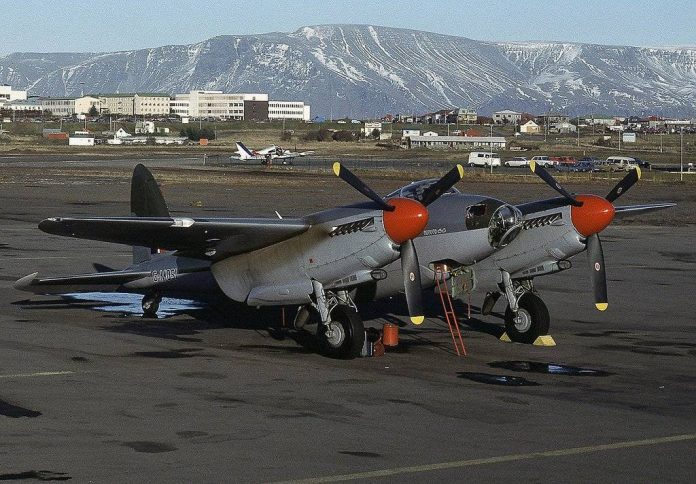
The story is just magical, you cannot call her otherwise than a miraculous transformation of a miracle into a monster. But in reality for Germany "Mosquito" became a headache, which they could not neutralize.
But it all started very, very sad.
In the mid 30s, when the tension was on the rise, by leaps and bounds, in the firm "De Havilland" began work on a certain project, which it turned out to be implemented exactly to 1938 year. That is, Europe was already divided with might and main by those, who could afford it, and before the start of World War II there was nothing left. But this was not yet known, but the essence of the question was completely different.
The most interesting, that there was no need to develop De Hevilland at all. On paper. Great Britain had four twin-engined bombers, theoretically covering absolutely the entire niche in the Royal Air Force. «Blenheim», «Whitley», «Wellington» and «Hempden».
Here you can throw stones at this four as much as you like. (especially at Whitley and Hampden), but they were. Verified, capable of performing the assigned tasks (or not very capable). But there were all-metal bomb carriers in Britain.
And here Sir Jeffrey De Hevilland is running around with a project of some kind of wooden structure (fi, last century), and even with Rolls-Royce motors. Motors not driven and very indistinct. It was then that the "Merlin" diamond sparkled with all its facets., but in the beginning we were very worn out with him.
Plus Sir Jeffrey constantly put pressure on the brains of defense officials, proving, that in the event of war, duralumin in a belligerent country on 100% will become scarce, and the woodworking industry, conversely, will be unloaded. The veracity of Sir De Havilland's calculations was confirmed very soon..
As the, that of the aforementioned four, only Wellington turned out to be more or less a combat aircraft. Rest, sadly to state, turned out to be outright flying junk. This was especially shown by the Japanese, cutting out all the "Blenheims" in Southeast Asia in just a month.
Generally, the war for british bomber aircraft began to put it mildly, Not really. And then there's Sir Geoffrey with his piece of wood ...
But Jeffrey De Havilland was a very gifted man.. And 1938 year built DH.95 «Flamingo».
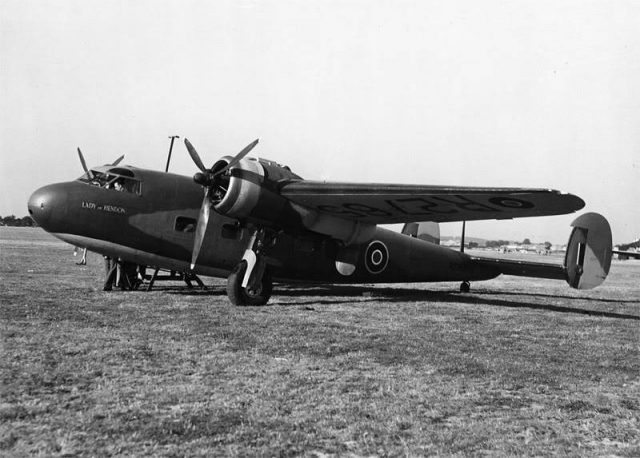
"Flamingo", true, was all-metal. The car was designed to carry 12-17 passengers and had a flight range of more than 2000 km, and the maximum speed was 390 kmh.
Well Sir Jeffrey just in case (well yes, almost by accident) gave instructions to perform approximate calculations for converting the liner into a bomber. properly, the Germans did this in general easily and naturally, worse than the British?
Remade. FROM 1000 kg of bombs the plane could fly 2400 km at an average speed 350 kmh. A plus 5 machine guns for defense. Generally, it happened so Albermal, which, although it went into series, turned out to be, probably, the worst British bomber.
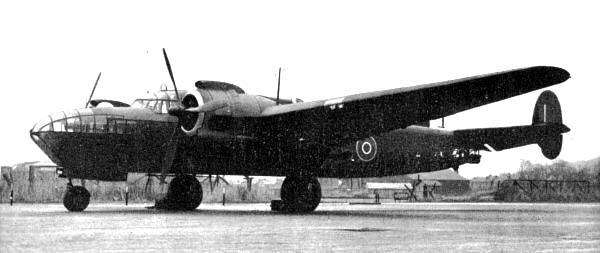
Sir Jeffrey continued with the tenacity of a woodpecker to hammer the idea of a high-speed wooden bomber. Furthermore, his ideas got a new round thanks to the work on "Albermal", and De Havilland decided to get rid of airborne defensive weapons altogether in favor of speed.
by the way, besides saving weight, voiced ... saving people! Machine guns can protect bomber from fighters, but anti-aircraft artillery - here they are powerless. Meanwhile, the development of anti-aircraft guns hinted at, that there won't be an easy walk. And then a direct calculation: the loss of two crew members of such a bomber, or 6-7 crew man of a four-engined bomber.
Meanwhile, facilitated by the removal of defensive rifle installations and their riflemen, the bomber will become more high-altitude, fast and agile, which will allow him to easily dodge like fighter attacks, and from enemy anti-aircraft fire.
Of course, the correctness of De Havilland's calculations could only be confirmed by practice. That is war.
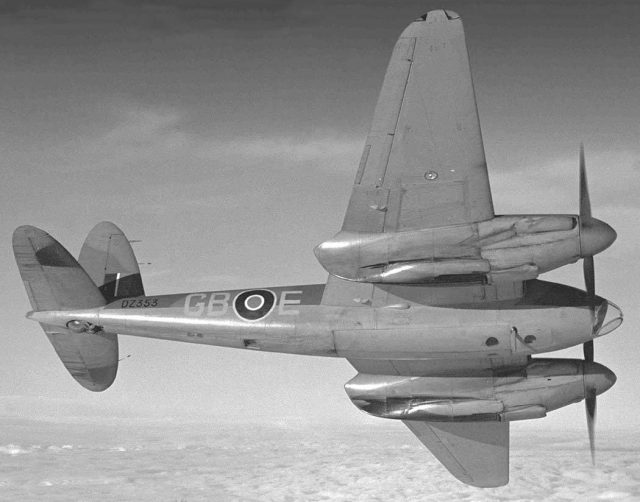
And she didn't keep herself waiting. And when the German air defense in the face of anti-aircraft batteries and fighters slightly thinned the formation of the British bomber aviation, here in the military department seriously thought about the proposal of De Hevilland. Well, the Messerschmitts turned out to be too fast.
At the end 1939 g. the firm "De Havilland" presented three new projects of a solid-wood unarmed bomber: two with motors «Merlin» and another one with the newest «Griffons».
according to the calculations, maximum speed of any of the options with a load 454 kg of bombs exceeded 640 kmh. Actually, the only fighter, who could oppose something to De Havilland's plane in terms of speed, surprisingly, at 1940 year was the Soviet MiG-1. The rest are doubtful.
In the end - it worked. And the prototype aircraft went into construction with two Rolls-Royce engines. «Merlin» RM3SM power 1280 HP. on high 3700 m 1215 HP. on high 6150 m.
There was a little trick in the design, simply impossible for designers from other countries. The design of the three-layer upholstery of the wing and fuselage was applied., which allowed to drastically reduce the number of reinforcing stringers, frames and ribs.
The upper and lower skin layers were made of plywood, and the middle layer is made of light balsa with spruce power pads. Balsa is the lightest tree, native to South America (from it Thor Heyerdahl built his raft "Kon-Tiki"), and spruce is Canadian black spruce, viscous and resilient wood which has been used for a long time in the maritime business.
Everything was glued together under pressure with formaldehyde glue, the lining of the car was easily putty and brushed before painting, after that it was pasted over with canvas. Since there were practically no seams, hence the excellent aerodynamic qualities.
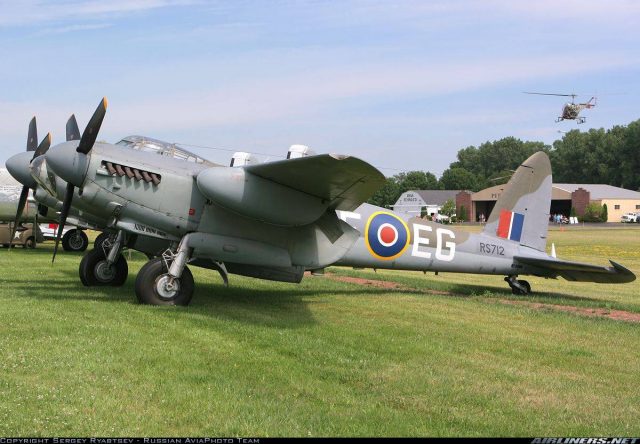
happened, and in March 1940 g. The Ministry of Aviation has signed a contract with De Hevilland to build 50 reconnaissance bombers. However, force majeure circumstances intervened in the form of problems in North Africa and Northern Europe and the deafening splash of Dunkirk..
All British efforts focused on the production of the Hurricane and Spitfire fighters, and Wellington bombers, Whitley and Blenheim.
«Mosquito» also got hit. De Havilland actually performed a miracle, by persuading Minister Beaverbrook not to stop production of Mosquito. In return, Sir Jeffrey promised to simplify the design of the aircraft so much., so that nothing can interfere with the construction of aircraft of the first stage, plus De Havilland, as a kind of compensation, promised to organize the repair of Hurricane aircraft and Merlin engines by the firm.
25 November 1940 of the year was the birthday of "Mosquito". It was on this day that the chief pilot of the firm Jeffrey De Hevilland Jr. (all three sons of Sir Jeffrey worked as test pilots of their aircraft, two died during trials) lifted the plane into the air for 30 minutes.
19 February 1941 g. the aircraft was transferred for state tests to the flight research center Boscombe Down. At first there was a rather frivolous attitude towards the plane., the small wooden structure did not command respect. But when it became clear, that the Mosquito flies faster than the Spitfire (about 30 kmh), attitude changed dramatically.
During tests at Boscombe Down, the maximum true flight speed 624 km / h was fixed at an altitude 6600 m at the flight weight of the car 7612 kg.
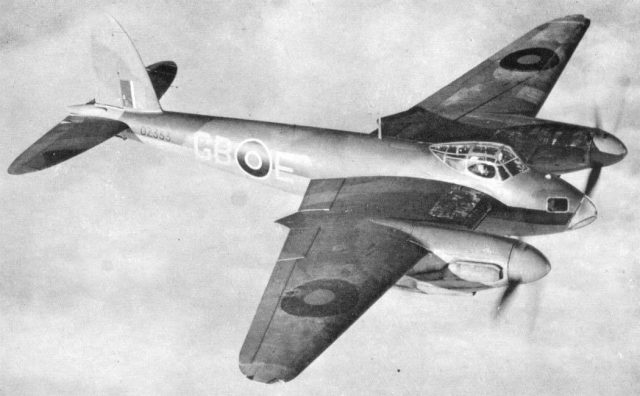
23 July 1942 g. plane on one flight, equipped with engines "Merlin-61", developed maximum speed 695 km / h at an altitude of 5100 m. In October 1942 g. the same aircraft with even more advanced engines "Merlin-77" managed to achieve the highest absolute indicator «The mosquito» — 703 km / h at an altitude of 8800 m.
Ordinary production vehicles flew, of course, a bit slower, and yet the leading production bomber B.IX in factory tests, held in March-April 1943 city, demonstrated speed 680 km / h at an altitude of 7900 m. Its power plant consisted of two engines «Merlin-72» capacity of 1650 HP. Faster «nines» at that time not a single serial fighter flew in the world.
In general, "Mosquito" can be safely called the first British multipurpose aircraft.
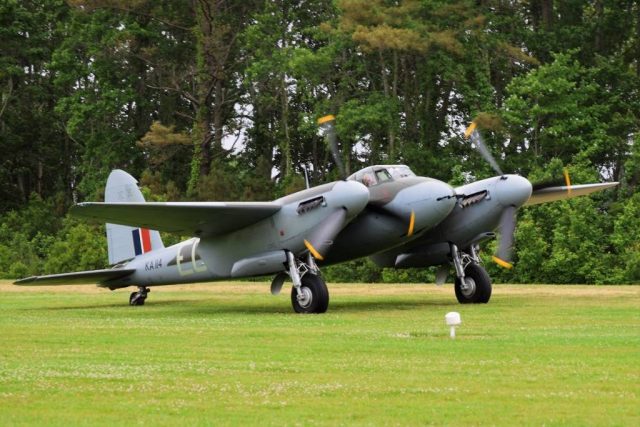
"Mosquito" worked as "clean" bombers, heavy fighters, scouts, were involved in providing night flights of four-engine bombers.
Mosquito jammed enemy radars, led large groups of aircraft to targets, marked targets with colored landmark-signal bombs. Actually, combined the functions of reconnaissance aircraft and electronic warfare.
Naturally, useful "Mosquito" and in the Royal Navy. They quite normally tracked enemy submarines and "treated" them with depth charges.
The locator in the nose "Mosquito" actually registered.
But the beginning of the Mosquito's combat path as a bomber, contrary to popular belief, can hardly be considered successful. Despite the stunning speed, the planes were still shot down by anti-aircraft artillery. In the first months of combat use, one loss accounted for an average of 9 sorties.
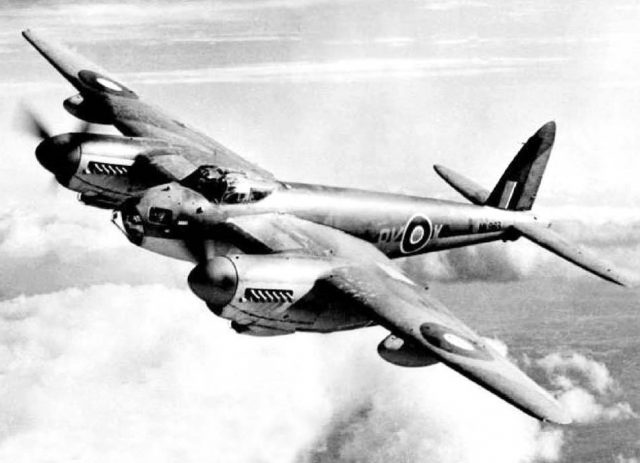
But there were also pleasant moments. It revealed, what FW-190 fighters at low altitude they cannot catch up with the Mosquito. It should be emphasized here, that in all cases German aircraft did not have an advantage in height. When the Germans attacked with superior height, British pilots had a very difficult time. Four FW-190A cannons turned a wooden structure into sawdust.
Interesting fact: the very existence of a new bomber in Britain was hidden not only from the enemy, but also from his audience. In summer 1942 g. only vague information about a certain "miracle plane" was leaked to the press.
Information was very scarce, in them, in the most general terms, the appearance of the car was outlined. Furthermore, to mislead the Germans, the British censorship carefully eliminated any mention of the absence of defensive weapons on the bomber version of the aircraft. conversely, in all articles, the reader was unobtrusively convinced that, that any «The mosquito» carries 4 machine gun and 4 gun. It was true, but only in relation to fighters and fighter-bombers.
Success and glory, and also serious propaganda success brought "Mosquito" destruction of the Gestapo building in Oslo. The British claimed, that during the fire burned more 12 thousand cases for Norwegians.
But the operation itself and its execution were quite: seven bombs hit the building out of twelve dropped, three punched him right through and exploded in the basement.
Yes, of course there were also German fighters (the same FW-190), who managed to knock out one of the "Mosquito", which fell on the territory of Sweden. The Germans also had losses, in the pursuit race, one of the Germans lost control and crashed.
FROM 1 June 1943 g. Bomber Command has officially ceased to participate in daytime tactical bombing of enemy territory.. In this regard, the functions have also changed. «The mosquito». The era of night raids harassing the German air defense system began.
properly, there was experience of such actions: even on the night of 21 April 1943 g. nine "Mosquito" defiantly attacked Berlin, congratulating the Fuhrer on his birthday.
Simultaneously, a large group of heavy bombers raided Stettin. The success was complete: the British recorded radiograms in the air defense control networks, containing a refusal to allocate additional fighters for the defense of Stettin, since the capital of the Reich itself was attacked.
This tactic of "pulling away" gave good results and subsequently became stereotyped. For a long time the Germans could not find effective countermeasures for her., because it was very difficult to come up with them due to the insufficient level of the then technology.
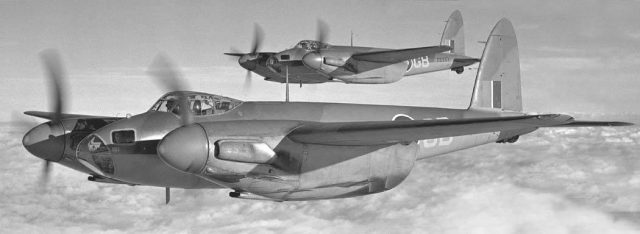
We are talking about a total deception of the German air defense detection system. Several Mosquitoes dropped strips of aluminum foil of a certain width, which are hanging in the air, disrupted the operation of radars and practically ruled out the determination of the scale of the raid.
And so a small group "Mosquito", interfering, on the radar screens blurred into a huge illumination, a plausible imitation of an armada of four-engined bombers.
Fighters climbed to intercept non-existent formations, wasting fuel and motor resources in vain. At the same time real «Lancaster» and «Halifax» turned into ashes a completely different German city.
The best example is surgery, spent the night of 22 June 1943 g. The distracting four "Mosquito" preliminarily setting a hindrance, bombed by Coulomb.
Naturally, interceptors were sent there. Naturally, even the German night fighters armed with "Liechtenstein" did not find anyone. At first, "Mosquito" has already escaped, and secondly, wooden structure with a minimum of metal (only motors) it was very difficult to take the radars of that time.
At this time, the main forces of the bomber command unleashed their attack on enterprises in the city of Mulheim..
Sometimes "Mosquito" was involved in the mining of water areas from the air. It was "Mosquito" who managed to block the channel of the port of Kiel with mines. Yes, a small dry cargo ship was blown up on the mines, slightly damaged. But it took a week to mine, during which the port was not working. The supply of the German group in Norway and the delivery of alloying materials from Sweden were actually disrupted..
In the autumn 1944 g. jet interceptors Me-163 and Me-262 appeared in the skies over Germany. The first ones were not at all scary due to their short flight range., with the second it was more difficult. But "Swallow" could not become a real threat to "Mosquito". It's about the maneuverability of the aircraft. Yes, 262-I was faster and could quite easily catch up with the Mosquito. But the turbines of the Messerschmitt engines did not have the necessary flexibility and the Mosquito easily left precisely due to the maneuver in the horizon..
We can not say, that many of these aircraft were manufactured. All were released 7700 Mosquito aircraft of all modifications, that, in general, not God knows what indicator.
Bombers "Mosquito" in the European theater of operations performed 26255 combat sorties. Due to the opposition of the Germans, they did not return to their airfields. 108 machines, and more 88 was written off due to combat damage.
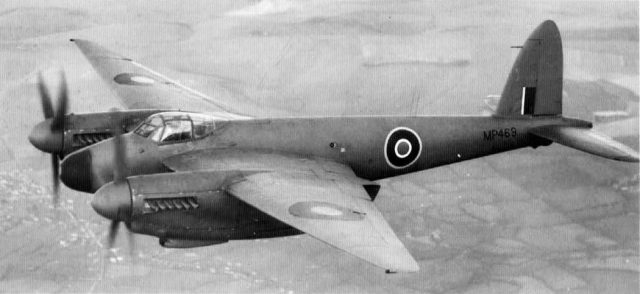
The only drawback of "Mossi", noted by the leadership of the Bomber Command in the final report for the war years, it turned out that circumstance, that “these planes were always too few…»
We got acquainted in detail with "Mosquito" and in our country. In 1944-1945. using «The mosquito» a courier connection was established between the governments of the USSR and Great Britain, and scouts regularly made landings at our northern airfields, when there was a hunt for "Tirpitz".
One copy came to the disposal of the Flight Test Institute (steer) NKAP, where is the leading pilot N. FROM. Rybko, test pilots P. I. Fedrovy and A. AND. Kabanov and Lead Engineer V. FROM. Pankratov carefully studied and flew around the plane.
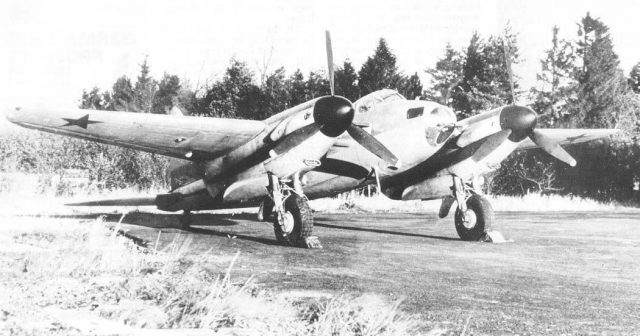
It revealed, that according to the flight characteristics "Mosquito" is actually equal to the Tu-2 with the same difference, that the latter had good defensive weapons, and the British plane was slightly faster over the entire altitude range. The bomb load was about the same.
"Mosquito" flew quite normally on one engine. It revealed, that it can perform deep turns with a roll towards the switched off engine. In general, the controllability of the British aircraft was highly appreciated.
There were also negative moments. It turned, that the bomber is unstable longitudinally, and its lateral and directional stability, by the measures of LII, was insufficient. Landing was relatively easy, but on the run, the car had a tendency to turn energetically.
Overall, the Mosquito was a very good aircraft., but required pilots of a high level of training, that in wartime it is not quite an easy task.
But in terms of operation, the car turned out to be beyond praise. Good access to main units, easy motor replacement, thoughtful and reliable benzo- and oil systems, an abundance of machines, facilitating the work of the crew in flight - all this made an impression on our experts.
clear, that the purpose of the tests at LII was with implications. The possibility of organizing a licensed (or unlicensed, as with Tu-4) produced by "Mosquito" in the USSR.
Yes, solid wood construction won over. Alas, but these dreams were not destined to come true, since the manufacturing technology of the wing and especially the fuselage turned out to be unacceptable for the Soviet aircraft factories.
To top it all, there was no balsa in our country, there were no motors, like "Merlin". Therefore, plans had to be abandoned.
strangely, of course, but the wooden plane turned out to be a very good combat vehicle. And despite the archaic nature of the materials, influenced aircraft manufacturers in other countries.
With a slight stretch, the real multipurpose aircraft Me-210 and Me-410 can be considered German copies of the Mosquito., what is there, the Germans themselves wrote, that this is the answer to the appearance of such a machine among the British. Here Myasishchev also created the Pe-2I project, very similar to the Germans, that is, all-metal.
But only the British Pinocchio "Mossi" has acquired such fame., served before 1955 of the year.
Characteristics of Mosquito B Mk.IV:
Wingspan, m: 16,51
Length, m: 12,43
Height, m: 4,65
wing area, m2: 42,18
Weight, kg:
- empty aircraft: 6 080
- normal take-off: 9 900
- maximum take-off: 10 152
Engine: 2 х Rolls-Royce Merlin 21 x 1480 HP.
full speed, kmh: 619
Cruising speed, kmh: 491
practical range, km: 2570
Skoropodъemnost, m / min: 816
Service ceiling, m: 10400
Crew, people: 2
weaponry:
bomb load up 908 kg: one 454 kg bomb and two 227 kg bombs or four 227 kg bombs.
/Roman Skomorokhov, topwar.ru/










